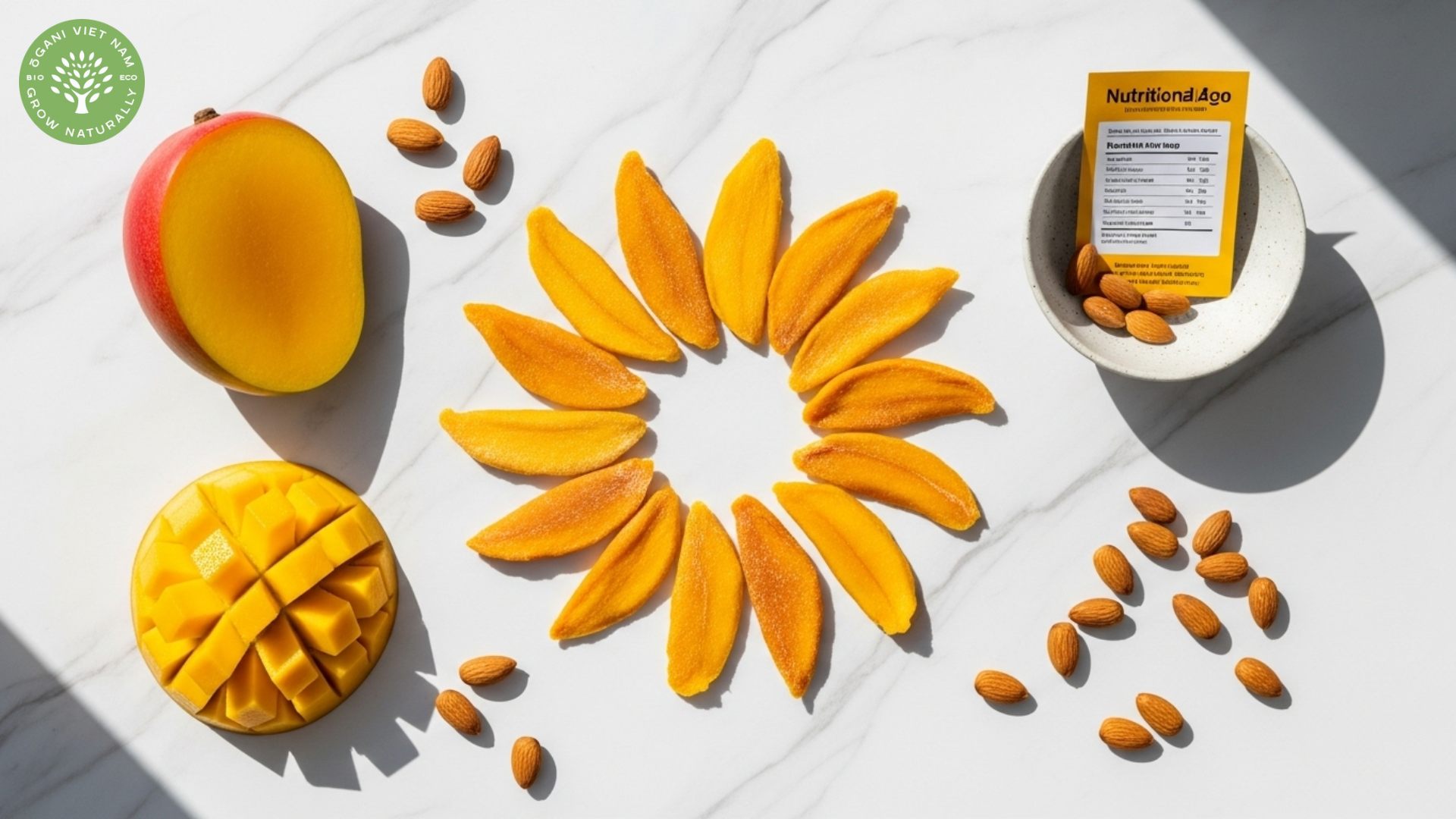When you’re searching for nutrition in dried mango, you’re looking at a concentrated source of vitamins A and C, fiber, and natural sugars—but with significantly higher calorie density than fresh mango. A typical 40-gram serving contains around 130-140 calories, making it a nutrient-rich snack that requires mindful portioning.
At Ogani VN, we’ve noticed customers often grab dried mango thinking it’s equivalent to fresh fruit, then wonder why their health goals stall. The truth? Dried mango offers genuine nutritional benefits, but understanding what you’re actually eating matters more than ever in 2025’s health-conscious market.
Understanding nutrition in dried mango: the complete breakdown
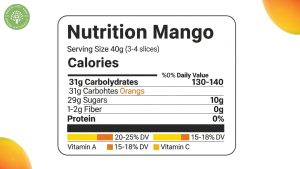
The dehydration process removes about 75-80% of water content, which fundamentally changes the nutritional profile. What you get is concentrated—both the good and the challenging aspects.
A standard 40-gram serving (roughly 3-4 slices) delivers approximately:
- 130-140 calories
- 31-33 grams of carbohydrates
- 29-30 grams of natural sugars
- 1-2 grams of dietary fiber
- Less than 1 gram of protein
- Minimal fat (under 0.5 grams)
The vitamin content deserves attention. You’re getting about 20-25% of your daily vitamin A requirement and 15-18% of vitamin C—impressive for a portable snack. Potassium levels hover around 150-200mg per serving, while folate and vitamin E appear in smaller but meaningful amounts.
Here’s where it gets interesting: unsweetened dried mango versus the sweetened varieties that flood grocery shelves. Many commercial brands add cane sugar or sulfur dioxide for preservation and color enhancement. We always tell our customers at Ogani VN—flip that package and read the ingredients. “Mango” should be the only word you see.
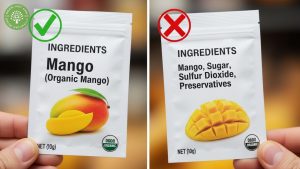
The caloric density catches people off guard. One fresh mango (about 200 grams of edible fruit) contains roughly 200 calories. That same amount, dried, balloons to 600-700 calories. You’re essentially eating three mangoes in concentrated form when you finish a small bag.
Health benefits from nutrition in dried mango
Digestive support from natural fiber
The fiber content in nutrition in dried mango, while not astronomical, contributes to digestive regularity. We’re talking about both soluble and insoluble fiber working together—soluble fiber helps moderate blood sugar spikes (though the high sugar content complicates this benefit), while insoluble fiber adds bulk to stool.
Customers tell us they notice improved bowel movements when incorporating dried mango into their routine, particularly those who struggle with mild constipation. The key word? Moderation. Overdoing it can flip the script and cause digestive discomfort due to concentrated fructose.
Immune function and antioxidant properties
One of the standout aspects of nutrition in dried mango is its vitamin C content, which supports immune system function—though heat during drying reduces some of the vitamin C present in fresh mango. You’re still getting a decent dose, but not the full amount you’d expect from biting into fresh fruit.
The real antioxidant star here is the carotenoid content, particularly beta-carotene (which converts to vitamin A in your body). These compounds combat oxidative stress and support skin health. We’ve had customers report better skin appearance after consistent dried mango consumption, though they’re also usually improving their overall diet simultaneously.
Mangiferin, a bioactive compound found in mangoes, survives the drying process relatively intact. Research from 2023 published in nutritional journals shows mangiferin exhibits anti-inflammatory and neuroprotective properties. Whether dried mango delivers therapeutic doses remains debatable—you’d need to eat substantial amounts.
Energy for active lifestyles
The natural sugar content in nutrition in dried mango provides quick energy, making it popular among hikers, cyclists, and gym-goers. At Ogani VN, we position it as a pre-workout option for customers needing fast-acting carbohydrates without artificial ingredients.
The glycemic load sits moderately high, meaning blood sugar rises fairly quickly after consumption. Pair it with protein (nuts, cheese, yogurt) to slow absorption and extend energy release. We’ve tested this combination ourselves during long workdays—it genuinely works better than eating dried mango solo.
Energy for active lifestyles
The natural sugar content provides quick energy, making dried mango popular among hikers, cyclists, and gym-goers. At Ogani VN, we position it as a pre-workout option for customers needing fast-acting carbohydrates without artificial ingredients.
The glycemic load sits moderately high, meaning blood sugar rises fairly quickly after consumption. Pair it with protein (nuts, cheese, yogurt) to slow absorption and extend energy release. We’ve tested this combination ourselves during long workdays—it genuinely works better than eating dried mango solo.
Sugar content in nutrition in dried mango: what you need to know
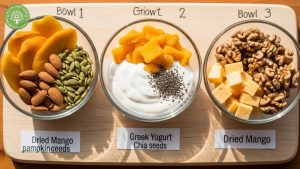
Let’s address the elephant in the room: nutrition in dried mango includes significant natural sugar content that impacts blood glucose levels.
Those 29-30 grams of sugar per serving equal about 7 teaspoons. Even though it’s naturally occurring fructose (not added refined sugar), your body processes it similarly. For context, the American Heart Association recommends women limit added sugars to 25 grams daily, men to 36 grams. One serving of dried mango nearly maxes out that guideline.
People with diabetes or insulin resistance need particular caution. The concentrated sugar hits your bloodstream faster than fresh mango due to reduced water content and fiber-to-sugar ratio. We advise our diabetic customers to treat dried mango as an occasional treat, not a daily staple, and always combine it with protein or fat.
The “fruit sugar doesn’t count” myth persists stubbornly. While dried mango contains beneficial nutrients alongside its sugar (unlike candy), excess fructose consumption links to fatty liver disease, increased triglycerides, and metabolic dysfunction when consumed regularly in large amounts. Balance matters more than source.
Maximizing nutrition in dried mango through smart portioning
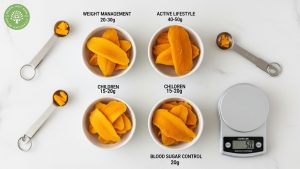
Here’s what we’ve learned from our own experience and customer feedback about actually implementing portion control:
The “mindless eating” trap hits hard with dried mango. Those chewy, sweet slices disappear quickly when you’re watching Netflix or working at your desk. We started pre-portioning dried mango into small containers—one serving per container—and it transformed consumption patterns.
Practical serving guidelines:
- For weight management: stick to 20-30 grams (about 2 slices) as an accent to meals
- For active individuals: 40-50 grams pre-workout provides adequate fuel
- For children: 15-20 grams satisfies sweet cravings without sugar overload
- For blood sugar concerns: maximum 20 grams, always paired with protein
Mix dried mango into trail mix with unsalted nuts, seeds, and a touch of dark chocolate. The protein and healthy fats slow sugar absorption while satisfying multiple taste preferences. Our most popular combination at Ogani VN combines dried mango with almonds, pumpkin seeds, and coconut flakes.
Rehydrate dried mango by soaking in warm water for 10-15 minutes before eating. This increases volume, slows eating pace, and slightly dilutes sugar concentration. Some customers swear this technique helps them feel more satisfied with less quantity.
Nutrition in dried mango versus fresh mango
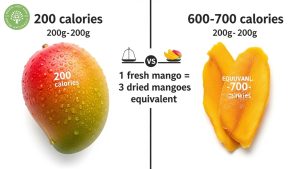
The fresh versus dried debate isn’t about declaring a winner—it’s about understanding trade-offs.
Fresh mango wins on:
- Higher water content (keeps you hydrated and fuller longer)
- More vitamin C (heat-sensitive vitamin degrades during drying)
- Lower calorie density (easier to manage portions)
- Natural satiety cues (eating fresh fruit sends better fullness signals)
Dried mango wins on:
- Portability and shelf stability (no refrigeration needed)
- Concentrated iron content (slightly higher per gram)
- Convenience for travel and outdoor activities
- Longer enjoyment time (chewy texture extends eating experience)
The fiber content remains relatively similar per gram, but you’ll consume less volume with dried mango, potentially reducing overall fiber intake per eating session.
For everyday nutrition, we recommend fresh mango as your primary choice at Ogani VN. Reserve dried mango for specific situations: traveling, hiking, emergency energy needs, or strategic pre-workout fueling.
One interesting pattern we’ve noticed: customers who rotate between fresh and dried forms maintain better nutritional balance than those exclusively eating one or the other. Variety keeps taste buds engaged and prevents overconsumption of any single form.
Frequently Asked Questions
Is dried mango good for weight loss? Dried mango can fit into a weight loss plan only with strict portion control. The high calorie density means even small amounts contribute significant calories. Treat it as a controlled treat (20-30 grams maximum) rather than unlimited snacking. Fresh mango serves weight loss goals better due to higher water content and better satiety.
How much dried mango should I eat per day? For most adults, 40-50 grams (about 3-4 slices) represents a reasonable maximum daily serving, preferably not consumed every single day. Active individuals with higher calorie needs can tolerate slightly more, while those managing blood sugar should limit intake to 20-30 grams or less, paired with protein.
Does dried mango have the same nutrients as fresh? Not exactly. Dried mango retains most vitamin A, potassium, and fiber, but loses 30-50% of vitamin C during the drying process. The concentration effect increases some nutrients per gram while dramatically increasing sugar and calorie density. Think of them as related but distinctly different foods.
Can diabetics eat dried mango? Diabetics can consume dried mango occasionally in very small portions (15-20 grams maximum), ideally combined with protein or healthy fats to slow glucose absorption. However, fresh mango in small quantities typically works better for blood sugar management. Always monitor individual glucose response and consult with healthcare providers.
What’s the difference between organic and regular dried mango nutritionally? The core macronutrient profile (calories, carbs, protein, fat) remains essentially identical. Organic dried mango avoids synthetic pesticides and often skips sulfur dioxide preservatives, which some people prefer for health or ethical reasons. The nutritional content difference is minimal—choose based on your priorities regarding farming practices rather than expecting major nutritional advantages.
Making dried mango work for your health goalsnutrition in dried mango
Nutrition in dried mango delivers genuine benefits—concentrated vitamins A and C, portable energy, satisfying natural sweetness—but demands respect for its caloric density and sugar content. The difference between healthy snacking and counterproductive overconsumption often comes down to portion awareness and strategic pairing with protein or healthy fats.
At Ogani VN, we believe in transparency about what you’re eating. Dried mango isn’t a superfood miracle, nor is it junk food disguised as health food. It’s a concentrated fruit product that serves specific purposes when used intelligently within your broader dietary pattern.
Ready to incorporate high-quality dried mango into your nutrition plan? Visit Ogani VN for organic, unsweetened dried mango options with complete transparency about sourcing and processing methods. We’ll help you choose varieties that align with your health goals—and teach you exactly how to enjoy them without derailing your progress. Contact our nutrition team today for personalized snacking strategies that actually work in real life.
Read more:
- Dried Mangoes Benefits: Healthy Snacking With Ogani VN.
- Dried Pineapple No Sugar Added: Healthy Snack by Ogani VN
- Dragon Fruit Powder: Unlocking Ít Superfood Potential for Health and Wellness.
- Dried Mango Benefits: 7 Amazing Health Reasons To Include This Superfruit In Your Diet
- Dried Mango Nutrition: Complete Guide To Health Benefits.


